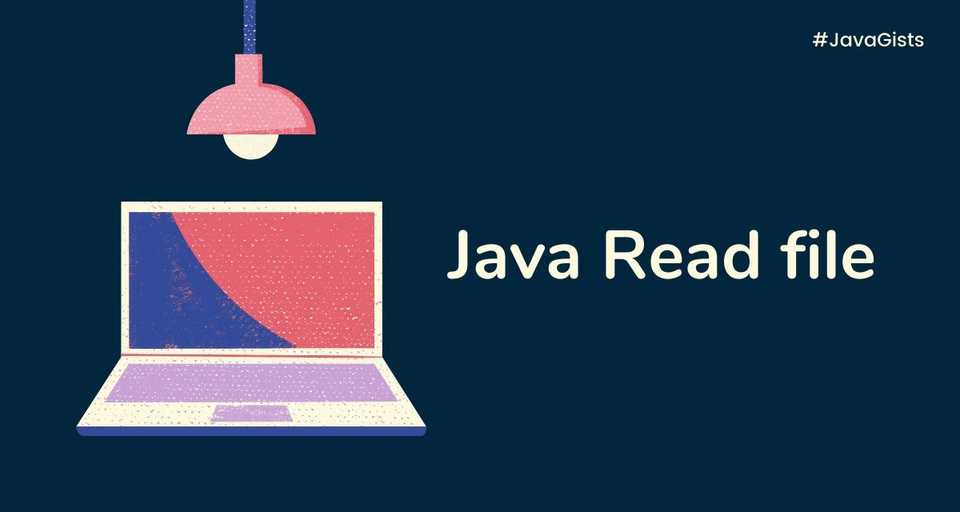In this article, you’ll learn how to read a text file or binary (image) file in Java using various classes and utility methods provided by Java like BufferedReader, LineNumberReader, Files.readAllLines, Files.lines, BufferedInputStream, Files.readAllBytes, etc.
Let’s look at each of the different ways of reading a file in Java with the help of examples.
Java read file using BufferedReader
BufferedReader is a simple and performant way of reading text files in Java. It reads text from a character-input stream. It buffers characters to provide efficient reading.
import java.io.BufferedReader;
import java.io.IOException;
import java.nio.charset.Charset;
import java.nio.charset.StandardCharsets;
import java.nio.file.Files;
import java.nio.file.Path;
import java.nio.file.Paths;
public class BufferedReaderExample {
public static void main(String[] args) {
Path filePath = Paths.get("demo.txt");
Charset charset = StandardCharsets.UTF_8;
try (BufferedReader bufferedReader = Files.newBufferedReader(filePath, charset)) {
String line;
while ((line = bufferedReader.readLine()) != null) {
System.out.println(line);
}
} catch (IOException ex) {
System.out.format("I/O error: %s%n", ex);
}
}
}Java read file line by line using Files.readAllLines()
Files.readAllLines() is a utility method of the Java NIO’s Files class that reads all the lines of a file and returns a List<String> containing each line. It internally uses BufferedReader to read the file.
import java.io.IOException;
import java.nio.charset.Charset;
import java.nio.charset.StandardCharsets;
import java.nio.file.Files;
import java.nio.file.Path;
import java.nio.file.Paths;
import java.util.List;
public class FilesReadAllLinesExample {
public static void main(String[] args) {
Path filePath = Paths.get("demo.txt");
Charset charset = StandardCharsets.UTF_8;
try {
List<String> lines = Files.readAllLines(filePath, charset);
for(String line: lines) {
System.out.println(line);
}
} catch (IOException ex) {
System.out.format("I/O error: %s%n", ex);
}
}
}Java read file line by line using Files.lines()
Files.lines() method reads all the lines from a file as a Stream. You can use Stream API methods like forEach, map to work with each line of the file.
import java.io.IOException;
import java.nio.charset.Charset;
import java.nio.charset.StandardCharsets;
import java.nio.file.Files;
import java.nio.file.Path;
import java.nio.file.Paths;
public class FilesLinesExample {
public static void main(String[] args) {
Path filePath = Paths.get("demo.txt");
Charset charset = StandardCharsets.UTF_8;
try {
Files.lines(filePath, charset)
.forEach(System.out::println);
} catch (IOException ex) {
System.out.format("I/O error: %s%n", ex);
}
}
}Java read file line by line using LineNumberReader
LineNumberReader is a buffered character-stream reader that keeps track of line numbers. You can use this class to read a text file line by line.
import java.io.*;
import java.nio.charset.Charset;
import java.nio.charset.StandardCharsets;
import java.nio.file.Files;
import java.nio.file.Path;
import java.nio.file.Paths;
public class LineNumberReaderExample {
public static void main(String[] args) {
Path filePath = Paths.get("demo.txt");
Charset charset = StandardCharsets.UTF_8;
try(BufferedReader bufferedReader = Files.newBufferedReader(filePath, charset);
LineNumberReader lineNumberReader = new LineNumberReader(bufferedReader)) {
String line;
while ((line = lineNumberReader.readLine()) != null) {
System.out.format("Line %d: %s%n", lineNumberReader.getLineNumber(), line);
}
} catch (IOException ex) {
System.out.format("I/O error: %s%n", ex);
}
}
}Java read binary file (image file) using BufferedInputStream
All the examples presented in this article so far read textual data from a character-input stream. If you’re reading a binary data such as an image file then you need to use a byte-input stream.
BufferedInputStream lets you read raw stream of bytes. It also buffers the input for improving performance.
import java.io.*;
import java.nio.file.Files;
import java.nio.file.Paths;
public class BufferedInputStreamImageCopyExample {
public static void main(String[] args) {
try(InputStream inputStream = Files.newInputStream(Paths.get("sample.jpg"));
BufferedInputStream bufferedInputStream = new BufferedInputStream(inputStream);
OutputStream outputStream = Files.newOutputStream(Paths.get("sample-copy.jpg"));
BufferedOutputStream bufferedOutputStream = new BufferedOutputStream(outputStream)) {
byte[] buffer = new byte[4096];
int numBytes;
while ((numBytes = bufferedInputStream.read(buffer)) != -1) {
bufferedOutputStream.write(buffer, 0, numBytes);
}
} catch (IOException ex) {
System.out.format("I/O error: %s%n", ex);
}
}
}Java read file into []byte using Files.readAllBytes()
If you want to read the entire contents of a file in a byte array then you can use the Files.readAllBytes() method.
import com.sun.org.apache.xpath.internal.operations.String;
import java.io.IOException;
import java.nio.file.Files;
import java.nio.file.Paths;
public class FilesReadAllBytesExample {
public static void main(String[] args) {
try {
byte[] data = Files.readAllBytes(Paths.get("demo.txt"));
// Use byte data
} catch (IOException ex) {
System.out.format("I/O error: %s%n", ex);
}
}
}